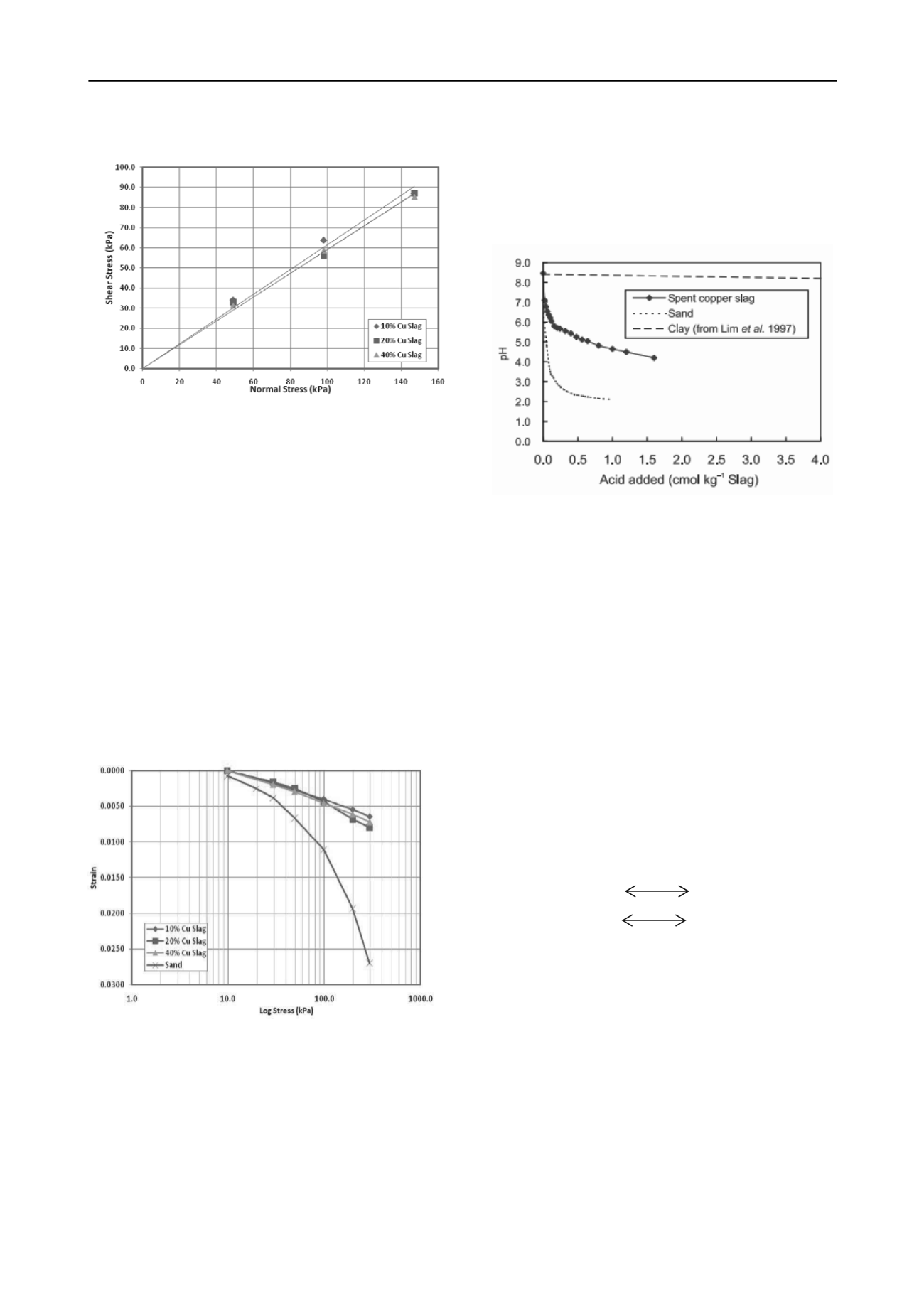
3245
Technical Committee 307 /
Comité technique 307
4 STIFFNESS
The most significant effect of the addition of waste copper slag
to sand was observed in confined compression tests. Dry
specimens were tested in a consolidation apparatus to ascertain
settlement and stiffness properties of the material. Standard
consolidation tests with fully saturated samples were not
warranted as the material had a very high hydraulic conductivity
and consolidation would have occurred at a rapid rate. Strains
were measured for different stress changes by applying loads on
to the sample.
Figure 5
shows the results in the form of a typical
strain vs log stress plot. There is clear distinction between the
behavior of the sand and the copper-sand mixes. The addition of
just 10% of waste copper slag drastically increases the stiffness
of the material. All three curves for copper-sand mixes are
tightly grouped which suggest that increasing the proportion of
copper slag more than 10% does not have any further effect.
Figure 5: Compression Characteristics of Copper-Sand Mixes
figure 6: Compression characteristics of copper-sand mixes
5 GEOCHEMICAL CHARACTERISTICS OF USED THE
COPPER SLAG
Chemical properties of the used copper slag as a percentage of
total weight are Iron Oxide-Fe
2
O
3
55%, Silica-SiO
2
35%,
Aluminium Oxide-Al
2
O
3
3.01%, Calcium Oxide-CaO 0. 20%,
Magnesium Oxide-MgO 0. 90%, Copper-Cu 0.42%, Titanium
Di-oxide 0.60%, and Potassium Oxide 1. 02% (Hammarstrom et
al.1999). The geochemical characteristic of used copper slag
can be analyzed for its element content, pH, acid neutralization
capacity (ANC), redox potential (Eh), and electrical
conductivity (EC). According to the previous research done by
Lim et al. (1997), it is clear that the pH of leachate generated
from the used copper slag is around 8.4. This pH value is within
the common pH range for soils and groundwater. Figure 6
shows the variation of pH- acid titration curves for used copper
slag and natural soils (Moyer et al. 2000).
Figure 7: pH- acid titration curves for used copper slag and natural soils
(After Moyer et al. 2000)
Figure 7
clearly illustrates that the used copper slag has a
rather low ANC in comparison with the clay. Sand has
practically negligible ANC. The low ANC value indicates that
the spent copper slag is not resistant to acid attack. The
concentration of Pb, Cd, Cr, Ba, As, Ag, Se, Cu, Zn, Ni and Hg
in the used copper slag leachate are fairly low. The leachabilitie
of Cu and Zn metals are much higher when compare with Cd,
Pb, Cr and Ni. The impact of the heavy metals leachability
would be nullified by dilution process under larger water: slag
ratio. Another important property of the used copper slag is the
Eh value. The initial Eh value for the used copper slag is 171
mV at a solid: water ratio of 1:1. The Eh would continue to
decrease rapidly days after placing the copper slag. Due to the
presence of sulphide minerals, the used copper slag can be
oxidized under oxic condition and release H
+
into the pore
water. As a result, there is a marginal drop in pH. The reduction
can be expressed by the following reactions such as reactions of
pyrite and ferrous. The amount of H
+
generated from this
reaction is very low and do not have enough reaction power to
make significant changes in double layer of clay minerals.
Pyrite oxidation:
4FeS
2
+ 14O
2
+ 4H
2
O 4Fe
2+
+ 8H
+
+ 8SO
4
2-
Fe (11) oxidation:
4FeSO
4
+ O
2
+ 10H
2
O 4Fe (OH)
3
+ 8H
+
+ 4SO
4
2-
The variation in pH due to present of heavy metals can be
affected to the groundwater pollution scenario. According to the
previous research done on used copper slag, it is clear that the
effect of groundwater pollution scenario is very unlikely to
occur (Lim et al. 1997).
Figure 4: Mohr-Coulomb Failure Envelopes for Copper-Sand Mixes
6 CONCLUSIONS
Results have show that the hydraulic conductivity of the
tested sand was hardly affected by the addition of waste copper
slag due to the void ratio and the hydraulic conductivity of the
waste copper slag itself being very similar to that of the sand.
Investigation of the geochemical characteristics of the used
copper slag alleviates the concern of possible groundwater
pollution by its use. Therefore, it can be concluded that used
copper slag can safely and effectively be used as a replacement
for sand in vertical drains.
The shear strength of properties of the tested sand-copper
slag mix was found to be very insensitive to the amount of


